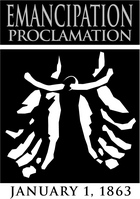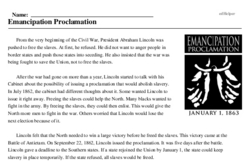Emancipation Proclamation
From the very beginning of the Civil War, President Abraham Lincoln was pushed to free the slaves. At first, he refused. He did not want to anger people in border states and push those states into seceding. He also insisted that the war was being fought to save the Union, not to free the slaves.
After the war had gone on more than a year, Lincoln started to talk with his Cabinet about the possibility of issuing a proclamation that would abolish slavery. In July 1862, the cabinet had different thoughts about it. Some wanted Lincoln to issue it right away. Freeing the slaves could help the North. Many blacks wanted to fight in the army. By freeing the slaves, they could then enlist. This would give the North more men to fight in the war. Others worried that Lincoln would lose the next election because of it.
Lincoln felt that the North needed to win a large victory before he freed the slaves. This victory came at the Battle of Antietam. On September 22, 1862, Lincoln issued the proclamation. It was five days after the battle. Lincoln gave a deadline to the Southern states. If a state rejoined the Union by January 1, the state could keep slavery in place temporarily. If the state refused, all slaves would be freed.




